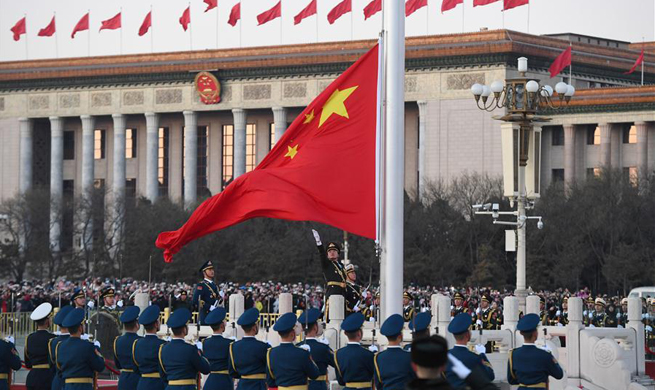KUALA LUMPUR, Jan. 2 (Xinhua) -- Malaysia's economy has beat market expectations in 2017, with its first three quarters growing at 5.6 to 6.2 percent year-on-year. However, heading into 2018, can the robust growth continue?
Overall, economists remain positive that Malaysia will continue its growth momentum, although the pace is likely to slow down from 2017 due to the high base this year.
Four key themes, namely the upcoming general election, the China-proposed Belt and Road Initiative, firmer Ringgit and potential rate hike, have been highlighted by economists as the country sets to achieve the official growth target of 5 to 5.5 percent in 2018.
ELECTION YEAR
The general election, which is due by the middle of this year, has been one of the key themes to watch out for Malaysian market in 2018.
Most analysts do not expect a political risk for the country, as they see the ruling Barisan Nasional, or National Front that led by Prime Minister Najib Razak will remain in power, mainly due to the split among the opposition.
Anticipating the country's policy direction to remain intact, analysts also expect higher consumer and government spending in the election year.
"Given that 2018 is an election year, the potential upsides government revenue provides room for increase in targeted spending," Maybank Investment Bank Research said in its recent report.
Indeed, recent oil prices rebound has provided some fiscal room for the Malaysian government to increase its spending this year as Malaysia remains a net exporter of oil and gas.
Projecting crude oil price to average 60 U.S. dollar per barrel in 2018, Maybank estimated that every 10 U.S. dollar increase in annual average crude oil price will boost government's oil and gas revenues by 4 billion ringgit (98 million U.S. dollars), and can be as much as 7 billion to 8 billion ringgit (1.72-1.97 billion U.S. dollars) after including the dividend by the state-owned oil giant Petronas.
The research house also expected the government consumption to increase to 5.8 percent in 2018 from 5.1 percent in 2017, to reflect the impact of back-to-back growth in Malaysian government operating expenditure of 6.5 percent under Budget 2018.
"With the 14th general elections due to be called before August 2018, Budget 2018 has lived up to expectations with a number of wide-ranging initiatives to put more money in the hands of consumers, especially lower income households," said Alliance DBS Research.
These initiatives, including personal income tax cuts, various cash handouts and increase in civil servants' overall emoluments, are expected to support the nascent recovery in consumer sentiment and consumption.
"Together with recent economic growth momentum, we believe these initiatives will provide the impetus for the much needed recovery in consumer sentiment," Alliance added.
BOOSTED BY BELT AND ROAD INITIATIVE
Another key theme that highlighted by analysts is the funding and cooperation under the Belt and Road Initiative, which would boost the infrastructure sector in the region. These projects include the East Coast Rail Link (ECRL) project, to be built by a Chinese company, that sets to improve the connectivity in Malaysia.
"We believe that in 2018, various infrastructure projects across the world will be financed under the B&R Initiative. This may lead to higher demand for commodities and sustained global economic growth," said Affin Hwang Capital.
The research house also estimated a sizable portion of the infrastructure projects worth an estimated 180 billion ringgit (44.32 billion U.S. dollars) to be funded by the Malaysian government special-purpose vehicles and foreign government soft loans with China playing a significant role.
Proposed in 2013, the Silk Road Economic Belt and the 21st Century Maritime Silk Road Initiative aims to build trade and infrastructure networks connecting Asia with Europe and Africa on and beyond the ancient Silk Road routes. Malaysia is one of the first countries that supported the initiative.
CIMB Research expects the B&R to continue to play a big role in catalyzing mega projects in 2018 for Malaysia.
"With the funding support of the B&R as an enabler, Malaysia, for the first time, has targeted to implement or roll-out four major rail projects simultaneously in 2018," it added.
These projects include the ECRL, Kuala Lumpur to Singapore High Speed Rail, the Mass Rapid Transit 3 and the Gemas-Johor Baru electrified rail double tracking, all of which are expected to involve Chinese participation.
FIRMER RINGGIT
The Malaysian currency, which outperformed the market in 2017, is likely to remain steady in 2018, though volatility remains as the United States Federal Reserves is set to hike rates.
"We maintain a positive outlook on the Ringgit on the back of improving domestic factors amid favorable external environment," Maybank Research said, forecasting the ringgit to strengthen to 3.95 against the U.S. dollar by the end of 2018.
Some of these domestic factors, including sustained growth pick-up backed by consumption, investment and exports as well as Malaysian Central Bank's initiatives to deepen and broaden domestic financial markets, were positive steps to restore foreign investors' confidence.
Maybank Research also sees the general election could lend further support for ringgit, as the local currency tends to strengthen in the lead-up to elections due to rising confidence.
Sustained current account surplus and rising foreign exchange, improving oil prices may also lend support to the currency, it added.
Other than the above factors, a weakening greenback, and accelerated repatriation of export proceeds by Malaysian exporters on expectations of further strengthening of the ringgit, also explained the improved sentiment on the local currency in the past year.
Due to these factors, AmBank Research expects the ringgit against the U.S. dollar to end 2018 at 3.98, with average of 4.12 throughout the year.
"These would still be at a discount to our fair values of 3.76 based on the real effective exchange rate model and 3.96 based on fundamental analysis," it added.
Last year, the ringgit gained about 10 percent to 4.05 against the U.S. dollar.
CENTRAL BANK RATE HIKE
It is also widely expected that Malaysian central bank, Bank Negara, will raise interest rate of 25 basis points as early as in the first policy meeting in 2018.
"We reiterate our call of one 25 basis point policy rate hike at Malaysian Central Bank's next meeting in January, driven mainly by concerns over financial imbalance risks," said Nomura Research.
Besides, the recently strong gross domestic product growth has likely opened a window for the central bank to normalize its accommodative monetary policy stance in January, which would coincide with the disbursement of a number of cash handouts announced in the 2018 budget, it said.
"While Malaysian Central Bank is not an inflation-targeting central bank, the continuation of headline inflation above the long-run average, coupled with the possibility of a gradual acceleration in core prices, suggests one 25-basis point hike to the Overnight Policy Rate (OPR) is likely in the first quarter," HSBC Research said in its report.
But due to Malaysia's household debt stock stands at a high share of GDP of 88 percent, with the dominant mortgage portion highly sensitive to the policy rate, it said, the central bank will have to proceed with caution.
"Consequently, we believe the central bank will only deliver one hike, which it will likely to refer as policy normalization, not outright tightening," it added.

















